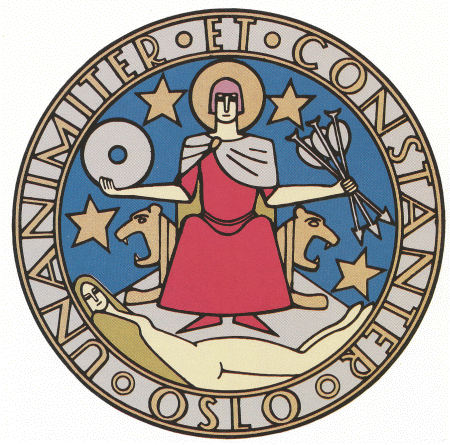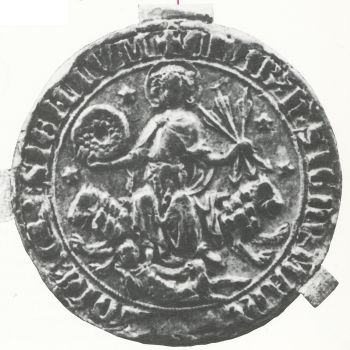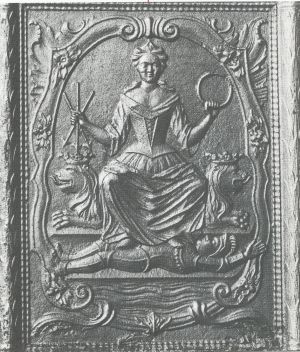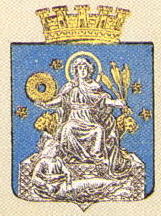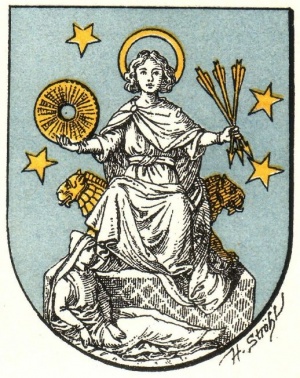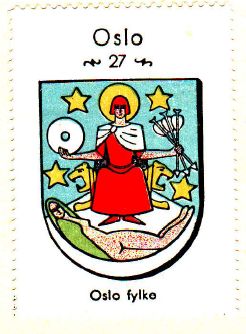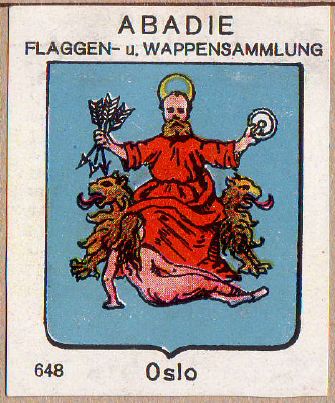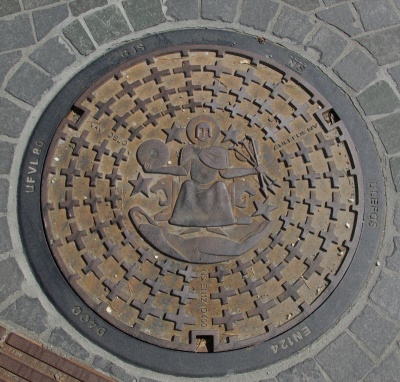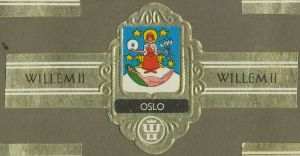Oslo: Difference between revisions
Knorrepoes (talk | contribs) m (Text replacement - "Hugo Gerhard Ströhl" to "Hugo Gerard Ströhl") Tags: Mobile edit Mobile web edit |
Knorrepoes (talk | contribs) m (Text replacement - "Literature :" to "'''Literature''': ") |
||
| (4 intermediate revisions by the same user not shown) | |||
| Line 1: | Line 1: | ||
{{no}} | {{no}} | ||
'''OSLO ''' | '''OSLO ''' | ||
[[File:oslo.gif|center| | [[File:oslo.gif|center|Coat of arms (crest) of {{PAGENAME}}]] | ||
{| class="wikitable" | |||
|+Official blazon | |||
|- | |||
|'''Norwegian''' | |||
| | |||
|- | |||
|'''English''' | |||
| blazon wanted | |||
|} | |||
===Origin/meaning=== | ===Origin/meaning=== | ||
Oslo is the only city in Norway that does not use a formal coat-of-arms, but a town seal. | Oslo is the only city in Norway that does not use a formal coat-of-arms, but a town seal. | ||
The seal of Oslo shows the city's patron saint, St. Hallvard. When starting to cross the Drammenfjord in 1043, Hallvard Vebjørnsson was approached by a woman who asked him to take her as she was pursued by three men. The men got furious and shot both Hallvard as well as the woman. The woman was buried on the shore, whereas the body of Hallvard was attached to a millstone and thrown into the sea, but, according to one version of the legend, Hallvard's body miraculously floated to the surface, thereby revealing the cruel deed. <br> | The seal of Oslo shows the city's patron saint, St. Hallvard. When starting to cross the Drammenfjord in 1043, Hallvard Vebjørnsson was approached by a woman who asked him to take her as she was pursued by three men. The men got furious and shot both Hallvard as well as the woman. The woman was buried on the shore, whereas the body of Hallvard was attached to a millstone and thrown into the sea, but, according to one version of the legend, Hallvard's body miraculously floated to the surface, thereby revealing the cruel deed. <br> | ||
| Line 23: | Line 32: | ||
After the Reformation the city continued the use of St. Hallvard. The second seal of Oslo dates from around 1590. It shows the same basic design, but the saint holds his attributes in the opposite hands. Also the stars and some other smaller details were lost. This seal was used until around 1660. <br> | After the Reformation the city continued the use of St. Hallvard. The second seal of Oslo dates from around 1590. It shows the same basic design, but the saint holds his attributes in the opposite hands. Also the stars and some other smaller details were lost. This seal was used until around 1660. <br> | ||
At the time the church of St. Hallvard has become a ruin and the legend was no longer well known. The third seal of Oslo, made in 1659, therefore showed still the basic design, but the saint was transformed into a woman figure. She still held the arrows and had a dead knight (with harnass and helmet) near her feet. The millstone had become thinner and looked more like a ring. This image can still be seen on an iron plate dating from 1770. These plates became very popular in Denmark in the 18th century and the figure was presented as Queen Margaret I, who unified the three Kingdoms of Sweden, Norway and Denmark, which are represented by the ring (union) and the three arrows. The dead kniight was to symbolise her opponent, Albrecht of Mecklenburg. | At the time the church of St. Hallvard has become a ruin and the legend was no longer well known. The third seal of Oslo, made in 1659, therefore showed still the basic design, but the saint was transformed into a woman figure. She still held the arrows and had a dead knight (with harnass and helmet) near her feet. The millstone had become thinner and looked more like a ring. This image can still be seen on an iron plate dating from 1770. These plates became very popular in Denmark in the 18th century and the figure was presented as Queen Margaret I, who unified the three Kingdoms of Sweden, Norway and Denmark, which are represented by the ring (union) and the three arrows. The dead kniight was to symbolise her opponent, Albrecht of Mecklenburg. | ||
{|align="center" | {|align="center" | ||
|align="center"|[[File:oslo4.jpg|center| | |align="center"|[[File:oslo4.jpg|center|Coat of arms (crest) of {{PAGENAME}}]] <br/>Iron plate dated 1770, with the image of the seal from 1659 | ||
|} | |} | ||
| Line 33: | Line 42: | ||
{|align="center" | {|align="center" | ||
|align="center"|[[File:oslo1.jpg|center| | |align="center"|[[File:oslo1.jpg|center|Coat of arms (crest) of {{PAGENAME}}]] <br/>The arms as shown in 1899. | ||
|} | |} | ||
| Line 39: | Line 48: | ||
{|align="center" | {|align="center" | ||
|align="center"|[[File:kristiania.sn.jpg|center|300 px| | |align="center"|[[File:kristiania.sn.jpg|center|300 px|Coat of arms (crest) of {{PAGENAME}}]] <br/>The arms by [[Hugo Gerard Ströhl|Ströhl]] in 1903. | ||
|align="center"|[[File:oslo.hagno.jpg|center| | |align="center"|[[File:oslo.hagno.jpg|center|Coat of arms (crest) of {{PAGENAME}}]] <br/>The arms in the [[Kaffe Hag Norge|Coffee Hag album]] +/- 1930 | ||
|- | |- | ||
|align="center"|[[File:oslo2.jpg|center| | |align="center"|[[File:oslo2.jpg|center|Coat of arms (crest) of {{PAGENAME}}]] <br/>The arms as shown in the German Abadie albums, mid 1930s | ||
|align="center"|[[File:oslocover.jpg|400 px|center| | |align="center"|[[File:oslocover.jpg|400 px|center|Coat of arms (crest) of {{PAGENAME}}]] <br/>The arms on a manhole cover (2015) | ||
|- | |- | ||
|align="center"|[[File:2084.wi2.jpg|center|300 px| | |align="center"|[[File:2084.wi2.jpg|center|300 px|Coat of arms (crest) of {{PAGENAME}}]] <br/>The arms on a Dutch [[Willem II]] cigar band | ||
|} | |} | ||
{{media}} | {{media}} | ||
[[Literature]] : Norske Kommunevåpen, Kommunalforlaget, 1987; http://no.wikipedia.org/wiki/Hallvard_Vebj%C3%B8rnsson, http://www.oslo.kommune.no | [[Civic Heraldry Literature - Norway|'''Literature''']]: | ||
Norske Kommunevåpen, Kommunalforlaget, 1987; http://no.wikipedia.org/wiki/Hallvard_Vebj%C3%B8rnsson, http://www.oslo.kommune.no | |||
[[Category:Norwegian municipalities O]] | [[Category:Norwegian municipalities O]] | ||
[[Category:Norwegian provinces]] | [[Category:Norwegian provinces]] | ||
Revision as of 13:29, 11 February 2024
| Heraldry of the World Verdens heraldikk |
| Norwegian heraldry portal Norsk Heraldik |
|
OSLO
| Norwegian | |
| English | blazon wanted |
Origin/meaning
Oslo is the only city in Norway that does not use a formal coat-of-arms, but a town seal.
The seal of Oslo shows the city's patron saint, St. Hallvard. When starting to cross the Drammenfjord in 1043, Hallvard Vebjørnsson was approached by a woman who asked him to take her as she was pursued by three men. The men got furious and shot both Hallvard as well as the woman. The woman was buried on the shore, whereas the body of Hallvard was attached to a millstone and thrown into the sea, but, according to one version of the legend, Hallvard's body miraculously floated to the surface, thereby revealing the cruel deed.
In another version hid nephews dregged up his body from the fjord.
There are also different versions about the woman, some legends state she was a normal woman, others that she was a slave, she has also been mentioned to be pregnant. In any case, after his death he became Saint Hallvard, and patron saint of Oslo.
The seal thus shows St. Hallvard with his attributes, the millstone and arrows, with the dead woman on his feet. He is seated on a throne with lion decorations, which at the time was also commonly used by the Norwegian Kings. By seating him on such a throne he was made equal to the kings. The three arrows are either a simple representation of the murder weapons, or for the three killed souls (Hallvard, the woman and the unborn child).
The oldest known seal of Oslo showed the same composition as the image above. The seal was probably made around 1300 and has been in use for nearly three centuries.
| The seal of Oslo from 1300 (image from a document from 1427). |
After the Reformation the city continued the use of St. Hallvard. The second seal of Oslo dates from around 1590. It shows the same basic design, but the saint holds his attributes in the opposite hands. Also the stars and some other smaller details were lost. This seal was used until around 1660.
At the time the church of St. Hallvard has become a ruin and the legend was no longer well known. The third seal of Oslo, made in 1659, therefore showed still the basic design, but the saint was transformed into a woman figure. She still held the arrows and had a dead knight (with harnass and helmet) near her feet. The millstone had become thinner and looked more like a ring. This image can still be seen on an iron plate dating from 1770. These plates became very popular in Denmark in the 18th century and the figure was presented as Queen Margaret I, who unified the three Kingdoms of Sweden, Norway and Denmark, which are represented by the ring (union) and the three arrows. The dead kniight was to symbolise her opponent, Albrecht of Mecklenburg.
| Iron plate dated 1770, with the image of the seal from 1659 |
During the 18th and early 19th century the image kept changing. The ring has been shown as a snake, the throne was replaced by a lion, the knight was not always present and similar variations. In 1854 A. T. Kaltenborn wrote about the Norwegian municipal arms and also was shown a medieval seal of Oslo. He recognised the St. Hallvard and the legend. He managed to persuade the city to have a new seal made, based on the old medieval composition.
Finally a new design was made by the German E. Doepler in 1892. He only changed one item on the old seal; in his design the woman was clothed instead of naked as on the seal. His composition was also used on a proper shield, as can be seen from the picture below. It was made in 1899 by Reidar Haavin.
| The arms as shown in 1899. |
In 1924 the present design was made, again with the naked woman. The composition has also been placed in a shield by different authors and with different colours as can be seen in the images below.
| The arms by Ströhl in 1903. |
The arms in the Coffee Hag album +/- 1930 |
| The arms as shown in the German Abadie albums, mid 1930s |
The arms on a manhole cover (2015) |
| The arms on a Dutch Willem II cigar band |
Contact and Support
Partners:
Your logo here ?
Contact us
© since 1995, Heraldry of the World, Ralf Hartemink 
Index of the site
Norske Kommunevåpen, Kommunalforlaget, 1987; http://no.wikipedia.org/wiki/Hallvard_Vebj%C3%B8rnsson, http://www.oslo.kommune.no



